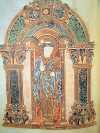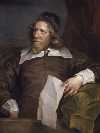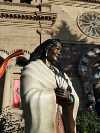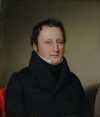Definition: (noun) A flat cake of thin batter fried on both sides on a griddle.
Synonyms: flannel-cake, battercake, flapcake, hotcake, pancake, griddlecake.
Usage: His flapjacks were so thin and light that they could have passed for crêpes.
Discuss
Source: The Free Dictionary
 Ball, an English priest and social reformer, gained fame as a roving preacher advocating ecclesiastical poverty and social equality, which brought him into conflict with the archbishop of Canterbury. He was jailed three times and excommunicated in 1376. Four years later, he became one of the instigators of the Peasant’s Revolt of 1381—the first great popular rebellion in English history—and was later captured and hanged, drawn, and quartered. His unconventional behavior earned him what nickname?
Ball, an English priest and social reformer, gained fame as a roving preacher advocating ecclesiastical poverty and social equality, which brought him into conflict with the archbishop of Canterbury. He was jailed three times and excommunicated in 1376. Four years later, he became one of the instigators of the Peasant’s Revolt of 1381—the first great popular rebellion in English history—and was later captured and hanged, drawn, and quartered. His unconventional behavior earned him what nickname?  When
When  Jones was one of England’s first great architects. After studying in Italy, he brought Renaissance architecture to England. His best known buildings are the Queen’s House at Greenwich, London, and the Banqueting House at Whitehall, which is often considered his greatest achievement. For his design of Covent Garden, London’s first square, Jones is credited with the introduction of town planning in England. Jones was also involved in stage design for theater and is credited with what innovations?
Jones was one of England’s first great architects. After studying in Italy, he brought Renaissance architecture to England. His best known buildings are the Queen’s House at Greenwich, London, and the Banqueting House at Whitehall, which is often considered his greatest achievement. For his design of Covent Garden, London’s first square, Jones is credited with the introduction of town planning in England. Jones was also involved in stage design for theater and is credited with what innovations?  As far back as Paleolithic times, Native Americans and other traditional peoples have believed the medicine man to be in possession of supernatural healing powers, such as the ability to inflict pain, promote fertility, and secure good hunting and fishing. Many Native Americans regarded illness as resulting from the entry of malignancy into the body; accordingly, their medicine men try to cast out the illness using ritual techniques such as bloodletting, the application of herbs, and what else?
As far back as Paleolithic times, Native Americans and other traditional peoples have believed the medicine man to be in possession of supernatural healing powers, such as the ability to inflict pain, promote fertility, and secure good hunting and fishing. Many Native Americans regarded illness as resulting from the entry of malignancy into the body; accordingly, their medicine men try to cast out the illness using ritual techniques such as bloodletting, the application of herbs, and what else?  Any nobleness begins at once to refine a man’s features, any meanness or sensuality to imbrute them.
Any nobleness begins at once to refine a man’s features, any meanness or sensuality to imbrute them.  English illustrator Edward Whymper developed an interest in mountaineering after being sent to sketch the mountain scenery of Switzerland in 1860. In 1865, after several failed attempts, he and his expedition party became the first to climb the Matterhorn—one of the last Alpine mountains to be ascended. Tragically, during the descent, four of his companions were killed in a fall. Whymper describes his experiences in Scrambles Amongst the Alps. What did he write about the accident?
English illustrator Edward Whymper developed an interest in mountaineering after being sent to sketch the mountain scenery of Switzerland in 1860. In 1865, after several failed attempts, he and his expedition party became the first to climb the Matterhorn—one of the last Alpine mountains to be ascended. Tragically, during the descent, four of his companions were killed in a fall. Whymper describes his experiences in Scrambles Amongst the Alps. What did he write about the accident?  The first Native American to be beatified,
The first Native American to be beatified,  An American journalist, playwright, and diplomat, Noah was the first Jew born in the United States to reach national prominence. After finding success as a diplomat, Noah held several public offices in New York City, edited and founded many newspapers, including the New York Enquirer and The Evening Star, and wrote plays such as She Would Be a Soldier. In the 1820s, he unsuccessfully attempted to buy Grand Island in the Niagara River to use for what purpose?
An American journalist, playwright, and diplomat, Noah was the first Jew born in the United States to reach national prominence. After finding success as a diplomat, Noah held several public offices in New York City, edited and founded many newspapers, including the New York Enquirer and The Evening Star, and wrote plays such as She Would Be a Soldier. In the 1820s, he unsuccessfully attempted to buy Grand Island in the Niagara River to use for what purpose?